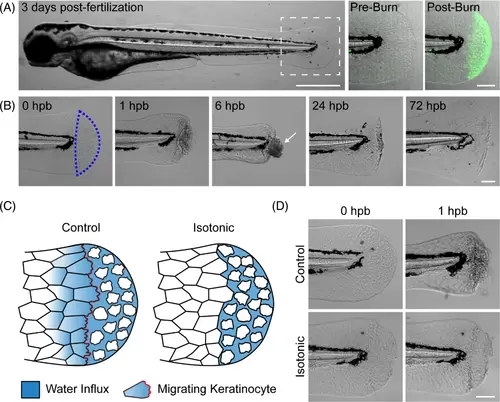Fig. 1
- ID
- ZDB-FIG-250114-15
- Publication
- Horn et al., 2025 - Isotonic medium treatment limits burn wound microbial colonisation and improves tissue repair
- Other Figures
- All Figure Page
- Back to All Figure Page
|
Burn injury generates local epithelial damage in larval zebrafish. (A) Larval zebrafish 3 days post-fertilisation. Dashed box indicates the tailfin region used for burn experiments. Scale bar = 500 μm. At right, representative images show a tailfin pre- and post-burn in the presence of cell impermeable FM dye. Increased dye fluorescence post-burn indicates localised tissue damage. Scale bar = 100 μm. (B) Time series showing a larval zebrafish tailfin at the indicated time, hours post-burn (hpb). Scale bar = 100 μm. (C) Schematic illustrating the effect of isotonic medium on keratinocyte dynamics after burn injury. In control (hypotonic) conditions, net fluid influx into damaged tissue and subsequent swelling of wound-edge keratinocytes stimulate a migratory response. Lack of fluid influx in isotonic conditions prevents keratinocyte swelling and cell migration. (D) Images showing control and isotonic medium treated larvae at the indicated time post-burn. Scale bar = 100 μm. |

